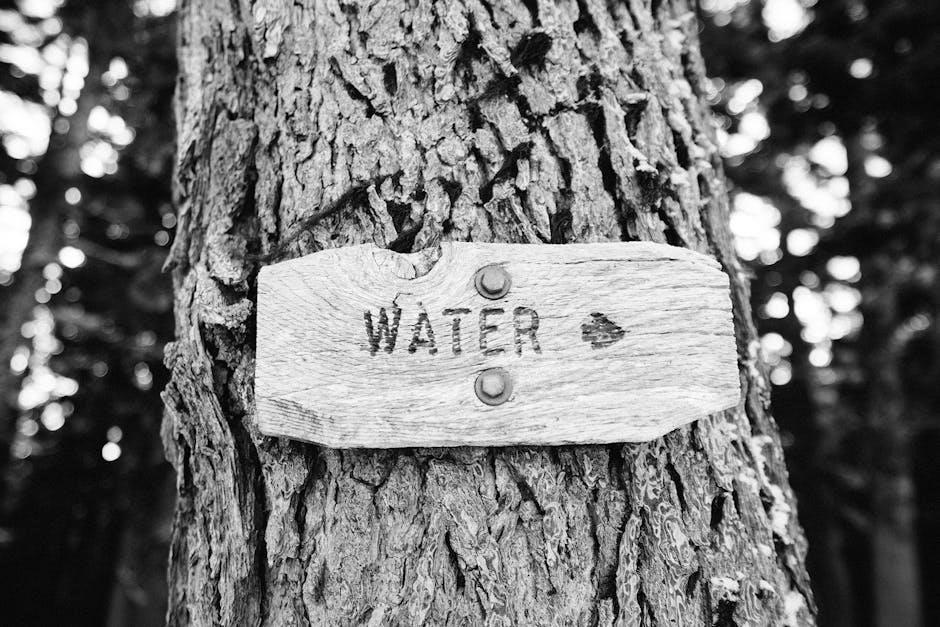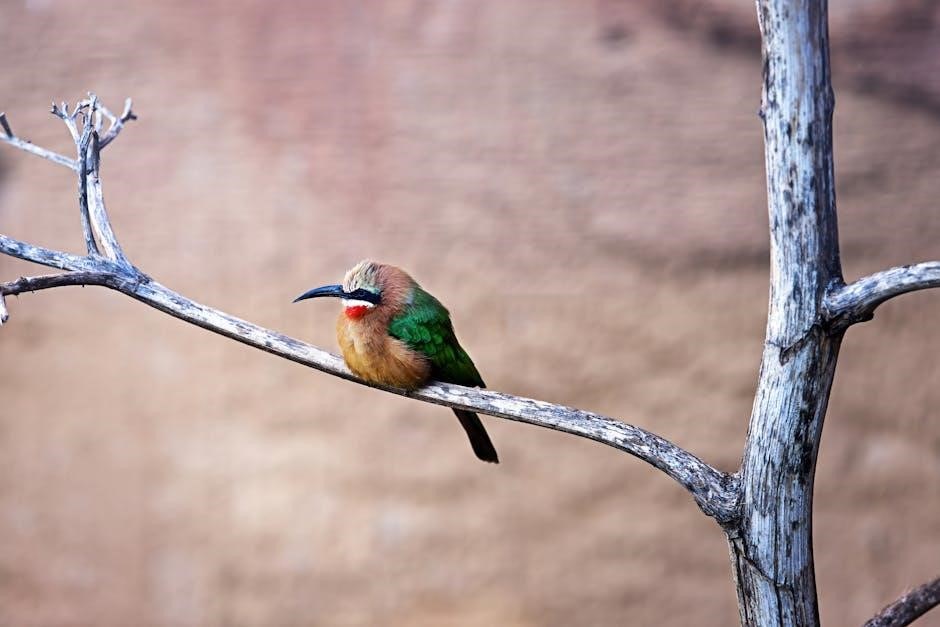Elm trees (Ulmus spp.) are deciduous giants, known for their adaptability and striking vase-shaped canopies. Native to temperate climates worldwide, they offer shade, beauty, and ecological value, making them a timeless choice for landscaping and conservation efforts.
Understanding the Elm Tree Species
Elm trees belong to the Ulmus genus, comprising over 30 deciduous species. Known for their distinctive vase-shaped growth, elms are prized for their hardiness and ornamental value. Species like the American Elm (Ulmus americana) and European Field Elm (Ulmus minor) are popular for landscaping. Siberian Elm (Ulmus pumila) is notable for its drought tolerance. Each species offers unique traits, making elms versatile for various environments and landscaping goals.
Why Grow an Elm Tree?
Elm trees are a valuable addition to any landscape due to their rapid growth, shade provision, and pollution tolerance. They enhance biodiversity by supporting various wildlife and serve as natural windbreaks. Elms are also known for their resilience to urban conditions, making them ideal for city planting. Their aesthetic appeal and ecological benefits make them a popular choice for homeowners and environmentalists alike.

Choosing the Right Location
Elm trees thrive in open spaces with full sun and well-drained soil. Ensure adequate room for growth, as they can become large. Proper drainage is essential for healthy root development.
Climate and Soil Requirements
Elm trees prefer temperate climates in USDA zones 2–9, thriving in areas with moderate temperatures and seasonal rainfall. They adapt to various soils but favor well-drained, fertile ground with a pH of 5.5–8.0. Avoid waterlogged soils to prevent root rot. Full sun is ideal, though young trees benefit from partial shade. Proper drainage and consistent moisture ensure healthy growth, making elm trees versatile for diverse landscaping needs.
Lighting and Space Needs
Elm trees thrive in full sun to partial shade, requiring at least six hours of direct sunlight daily for optimal growth. They need ample space to develop their expansive canopies, which can reach up to 50 feet in width. Planting in open areas ensures proper air circulation and prevents overcrowding. Avoid shading young trees to promote healthy development and maximize their potential as majestic shade providers.

Obtaining Elm Tree Seeds or Saplings
Elm tree seeds, known as samaras, can be collected in spring. Saplings are available at nurseries or online, ensuring a healthy start for your elm tree journey.
Where to Source Elm Seeds
Elm seeds, or samaras, can be collected from mature trees in spring or purchased from reputable nurseries and online suppliers. For optimal results, gather seeds from healthy, disease-free trees, ensuring they are fresh and free of damage. Local tree farms or arboretums often provide high-quality seeds suited to your climate. Store seeds in a cool, dry place until planting to maintain viability and germination potential.
How to Select Healthy Saplings
Choose elm saplings with straight trunks, vibrant green leaves, and well-developed root systems. Avoid saplings with signs of pests, disease, or yellowing leaves. Opt for trees with a balanced canopy and no visible damage. Ensure the sapling is appropriate for your climate zone and soil type. Purchase from reputable nurseries or tree farms to guarantee quality. A healthy sapling will establish itself quicker and thrive in its new environment.

Planting the Elm Tree
Planting an elm tree requires careful preparation and timing. Choose a location with adequate space and suitable soil, ensuring proper drainage and sunlight exposure. Dig a hole twice the root ball’s width, place the sapling, and fill with soil, tamping gently. Water thoroughly to settle the soil, promoting healthy root establishment and initial growth.
Preparing the Soil
Elm trees thrive in well-draining, fertile soil. Test your soil to ensure it is slightly acidic to neutral (pH 6.0–7.5). If necessary, amend the soil with organic matter like compost to improve structure and fertility. Loosen the soil to a depth of 12 inches to promote root growth. Mix in a 2-inch layer of compost or mulch to enhance moisture retention and suppress weeds. Gently rake the area to create a smooth, even surface for planting. Water the soil lightly before planting to settle it and provide initial moisture.
Planting Seeds vs. Saplings
Planting seeds offers a cost-effective, long-term solution but requires patience, as germination and growth can take years. Ensure seeds are fresh and sown 1-2 inches deep in well-prepared soil. Saplings, however, provide faster results and higher survival rates. Choose healthy saplings with a well-developed root system. Dig a hole twice the root ball’s width, place the sapling at the same depth as in the nursery, and water thoroughly. Proper planting ensures robust growth and a strong foundation for your elm tree.
Ongoing Care and Maintenance
Regular watering, pruning, and fertilization are essential for elm trees. Water deeply during dry spells, prune diseased branches, and apply balanced fertilizers annually to promote healthy growth and resilience.
Watering and Irrigation
Elm trees require consistent watering, especially during their first year of growth. Water deeply once or twice a week, depending on climate conditions. Check soil moisture by inserting a finger into the soil up to the knuckle; water only if it feels dry. Avoid overwatering, as it can lead to root rot. During droughts, mature trees still need occasional watering to maintain health. Proper drainage is essential to prevent waterlogged soil.
Fertilization and Pruning
Feed elm trees annually with a balanced, slow-release fertilizer in early spring or late fall. Avoid over-fertilizing, as it can harm root health. Prune in late winter or early spring to remove dead, diseased, or crossing branches. This promotes airflow, reduces disease risk, and maintains a strong structure. Pruning also helps shape the tree for aesthetic appeal and ensures proper growth patterns. Regular maintenance ensures the tree remains healthy and vigorous.

Common Pests and Diseases
Elm trees are susceptible to Dutch Elm Disease, elm beetles, and scale insects. These pests and diseases can weaken the tree, leading to defoliation and decay. Regular monitoring and proper sanitation are essential for maintaining tree health and preventing the spread of infections.
Identifying Pests
Common pests of elm trees include the elm beetle, aphids, and scale insects. Elm beetles are often reddish-brown and feed on leaves, causing defoliation. Aphids are tiny, soft-bodied insects that secrete honeydew, attracting ants. Scale insects appear as small, immobile bumps on branches. Regular inspection of leaves and stems is crucial for early detection, ensuring timely intervention and protecting the tree’s health from significant damage.
Managing Diseases
Elm trees are susceptible to diseases like Dutch elm disease and root rot. Dutch elm disease, caused by fungi, can kill trees quickly. Infected branches should be removed immediately, and nearby soil treated to prevent spread. Root rot occurs in waterlogged soils; improving drainage and pruning affected roots can help. Regular tree inspections and maintaining healthy growing conditions are vital to prevent disease outbreaks and protect the tree’s longevity.

Propagation Methods
Elm trees can be propagated through seeds or cuttings. Seeds germinate readily, while cuttings from mature trees root reliably. Both methods require proper care and nurturing conditions.
Growing from Cuttings
Elm trees can be propagated successfully using cuttings taken from mature trees. Cuttings should be collected in early spring or late winter, ensuring they are fresh and healthy. Dip the cut ends in rooting hormone to enhance growth. Plant them in well-draining soil, water regularly, and provide indirect sunlight. Roots typically develop within weeks, with new growth appearing soon after. Proper care ensures strong, vigorous seedlings.
Seed Germination Techniques
Elm tree seeds require proper preparation for successful germination. Soak seeds in water for 24-48 hours before sowing. Stratification, a period of cold storage, enhances germination rates. Store seeds in moist peat moss at 35-45°F for 30-60 days. Sow seeds ¼ inch deep in well-draining soil, ensuring adequate moisture and indirect sunlight; Maintain consistent soil temperature around 70°F; Germination typically occurs within 1-3 months, yielding vigorous seedlings ready for further growth and care.

Growth Stages and Development
Elm trees progress from seed germination to sapling growth, maturing into robust shade trees with expansive canopies, and can live for decades, adapting to various environmental conditions gracefully.
From Sapling to Maturity
Elm saplings develop rapidly, their roots establishing a strong foundation while their canopies expand. Within years, they mature into towering, vase-shaped trees, offering shade and habitat for diverse wildlife. Proper care, including regular watering and pruning, ensures their robust growth and longevity, transforming them into majestic, enduring landmarks in any landscape.
Monitoring Growth Progress
Regularly inspect the tree for healthy leaf growth, vibrant color, and robust branching. Measure trunk circumference and height annually to track development. Inspect roots for signs of establishment and expansion. Adjust watering, fertilization, and pruning as needed to support optimal growth. Seasonal observations help identify patterns and ensure the tree thrives, progressing smoothly from youth to maturity with consistent, attentive care.

Pruning and Training
Prune elm trees to maintain shape, health, and strength. Train young trees by shaping their branches to enhance structure and promote balanced growth for a sturdy, aesthetically pleasing canopy.
Pruning for Shape
Prune elm trees annually to achieve desired shapes, removing dead or crossing branches. Focus on maintaining a balanced canopy for aesthetic appeal and structural integrity, ensuring light penetration and healthy growth patterns.
Use sharp tools to minimize damage, cutting just above growth nodes. Prune in late winter or early spring to avoid stressing the tree, fostering a natural, symmetrical form that enhances its beauty and functionality in landscapes and gardens.
Training the Tree
Training an elm tree involves guiding its growth from an early stage to achieve a desired structure. Start by selecting a strong central leader and remove competing branches to promote vertical growth. Use stakes to support young trees if necessary, ensuring proper alignment. Regularly inspect and prune to maintain balance, encouraging a sturdy framework that supports the tree’s natural vase-shaped form and maximizes its ornamental value in landscapes. This practice ensures longevity and aesthetic appeal.

Harvesting and Utilization
Elm wood, known for its strength and flexibility, is harvested from mature trees for furniture-making and construction. The inner bark is also used for rope and crafts.
Harvesting Seeds
Elm seeds, also known as samaras, are harvested when mature and dry, typically in late spring. They should be collected from the tree or gathered from the ground, ensuring they are free of debris. Store them in a cool, dry place to maintain viability for planting. Proper timing is essential to ensure successful germination and growth of new elm trees.
Uses of Elm Wood
Elm wood is highly valued for its strength, durability, and resistance to splitting, making it ideal for furniture, flooring, and paneling. Its interlocking grain enhances stability, particularly in damp conditions. Historically, elm was used in shipbuilding and for making tool handles. The wood also serves as excellent firewood and is sometimes used for smoking meats, adding a unique flavor. Its versatility makes it a prized material for both practical and artisanal purposes.



